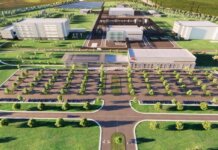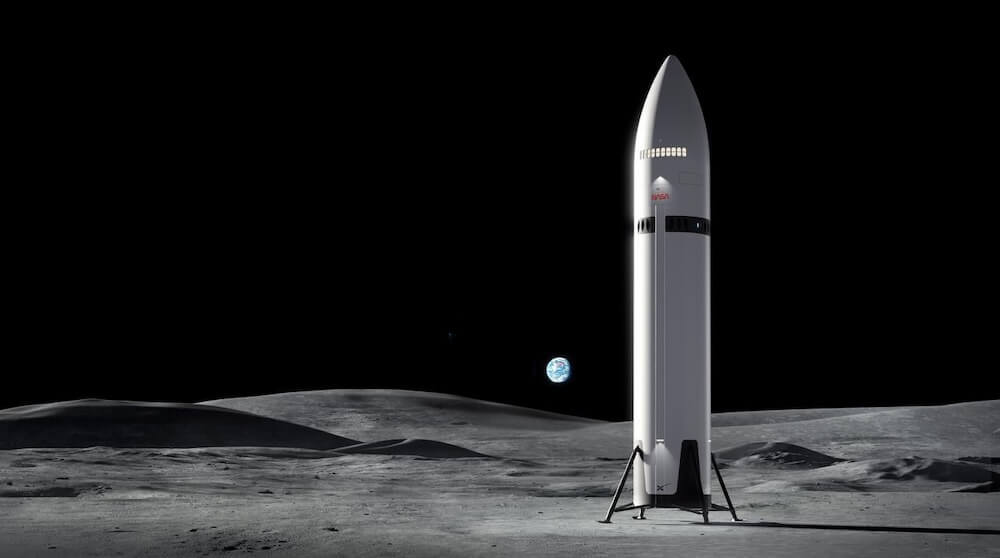
On July 1, 1960, President Dwight Eisenhower made a special visit to Huntsville to formally dedicate a new NASA field installation. The George C. Marshall Space Flight Center celebrates its 65th anniversary this year. The center, one of NASA’s largest, remains an integral part of the U.S. space program, from supporting nearly every phase of space exploration to leading groundbreaking scientific achievements.
In the 1960s, Marshall developed the Mercury-Redstone rocket that carried the first American astronaut into space, the Saturn I and Saturn IB rockets and the Saturn V rocket that carried the first humans to the Moon.
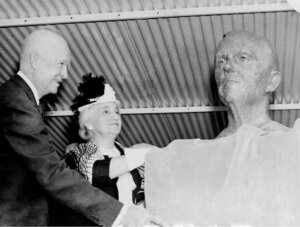
In 1970, the U.S. Space & Rocket Center, Marshall’s official visitor center, opened its doors. Today, it is the world’s largest space attraction and Alabama’s top paid tourist attraction, drawing millions of visitors from around the world. The center features dozens of interactive exhibits that showcase the past, present and future of spaceflight as well as a planetarium and one of the world’s largest collections of space hardware, including a full-scale Saturn V rocket. The center also is home to the Space Camp program, which offers children an opportunity to participate in fully immersive science, engineering and spaceflight learning programs.
During the 1970s, Marshall focused on developing the first U.S. space station, Skylab, and began developing and testing for NASA’s newly proposed Space Shuttle Program. Trailblazing efforts in the 1980s led to the STS-1 shuttle mission that ushered in three decades of low Earth orbit space operations as well as the first Spacelab mission launch. Two of the most sophisticated space telescopes and imagers ever built — the Hubble Space Telescope and the Chandra X-ray Observatory — launched in the 1990s, and both are still in operation today.
Marshall’s portfolio continued to expand in the beginning of the 21st century. The addition of the Destiny laboratory module to the International Space Station in 2001 increased onboard living space by 41%. It still serves as the primary research laboratory for U.S. payloads and supports a wide range of studies that contribute to improving life for people all over the world. That same year, the Payload Operations Integration Center at Marshall began providing 24/7 payload operations support for crews on the space station.
In the 2010s, Marshall wrapped up 40 years of overseeing propulsion for the Space Shuttle Program and turned to leading the Space Launch System (SLS), the agency’s most powerful launch vehicle to date and the backbone of NASA’s current major endeavor, the Artemis missions.
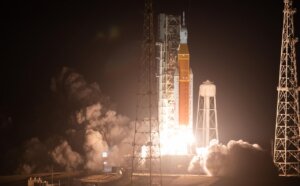
“For over six decades, Marshall has been a part of leading so many of humanity’s greatest achievements in space exploration,” says Joseph Pelfrey, who has served as director of Marshall Space Flight Center since early 2024 where he oversees more than 6,000 civil service and contractor employees and an annual budget of approximately $5 billion.
Prior to becoming director, Pelfrey spent a large part of his career in various leadership roles within NASA, including supporting the International Space Station. Marshall has served as the central hub for science activities on the space station for nearly 25 years.
“Our teams have the ability to utilize, really, a world-class laboratory in low Earth orbit to advance our knowledge and understanding of many different disciplines. We also use it to test the things we’re going to need to go further out in space, to spend longer spans on the lunar surface and to eventually make that long trip to Mars.”
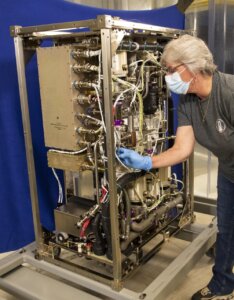
One example Pelfrey highlights is the Environmental Control and Life Support System (ECLSS), a life support system that provides or controls all aspects of air, water and waste systems for human space exploration. Three key components of ECLSS — the Oxygen Generation System, which produces oxygen; the Air Revitalization System, which cleans and circulates cabin air; and the Water Recovery System, which provides clean water by reclaiming wastewater, including crew members’ urine — were jointly designed and tested by Marshall and industry partners.
“It kind of freaks people out when we talk about the fact that urine becomes drinking water,” says Lisa Bates, director of the Engineering Directorate at Marshall. “But yes, it’s absolutely drinkable, and it’s actually really clean.”
Bates oversees more than 2,500 civil service and contractor personnel responsible for designing, testing, evaluating and operating flight hardware and software for Marshall-developed space transportation and spacecraft systems, science instruments and payloads.
“We have a huge job, and it’s an amazing job,” says Bates. “We can design it, we can develop it, we can test it and then we can actually deliver systems and components.” That start-to-finish product development is a unique capability and is why her team has built expertise in many areas.
Right now, a lot of that expertise is focused on preparations for Artemis II, the first crewed flight of the SLS and Orion spacecraft, scheduled for the early spring of 2026 that will launch four astronauts around the moon. Building on the success of the uncrewed Artemis I mission, which launched in November 2022, Artemis II is the next step toward establishing a long-term presence on the moon and preparing for future human missions to Mars. On its heels, Artemis III is scheduled for 2027 and will put humans on the moon for the first time in more than 50 years.
Working with industry partners, Marshall leads the development of the SLS and Orion. NASA awarded a contract to SpaceX to develop its Starship Human Landing System (HLS) that will carry Artemis III astronauts from lunar orbit to the moon’s surface and back, and Marshall is managing that program as well.
“One of the unique things about NASA is we have the ability to work a number of partnership avenues,” says Pelfrey.
Pelfrey looks forward to the new possibilities at Marshall when Space Command headquarters relocates to Huntsville.
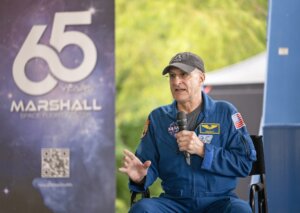
“We have a lot of active partnerships with other government agencies, including Space Force and Space Command, and that’s a normal course of business for us. There are over 65 federal organizations that sit within five miles of us, centralized here on Redstone Arsenal, and we partner a lot with those organizations in various ways. The possibility of Space Command coming to Huntsville is exciting because we have a lot of common areas where we can work together on capability development for the region. It would really create a strong space presence here in Huntsville, for sure, and leverage what we’ve built over the last 65 years, not only with NASA, but with our [defense] partners here on Redstone Arsenal.”
NASA has an $8 billion impact on Alabama’s economy and supports more than 35,000 jobs.
“The work that we do at Marshall [touches] many counties in Alabama. It is very much a whole nation approach to build this rocket, but definitely a large contribution [from] Alabama. And Alabama contributes to our missions, bringing its talent and expertise to help us solve challenges, build the hardware we need and help us get ready to launch these crews and support these missions.”
“Some people don’t know how important Marshall engineering is to the Artemis II flight,” says Bates, who has engineers working on a slew of preparations both at Marshall and NASA’s Kennedy Space Center to ensure a successful launch. “Obviously, their primary job right now is to make sure that we have a safe and perfect flight on Artemis II.”
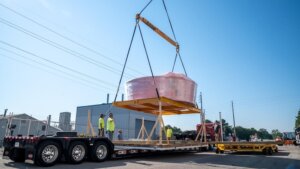
In August, a semitrailer transported the Orion stage adapter, which was built and tested at Marshall, to Kennedy to complete final stacking operations.
“The launch vehicle components are stacked on the launch tower at Kennedy Space Center and have undergone initial integrated testing,” says Pelfrey. “And the Orion spacecraft is finishing up its processing. It will be stacked in the coming months, and then our goal is to actually roll out to the launch pad for initial testing by the end of the calendar year. It is an exciting time.”
For Bates, who was part of NASA’s Space Shuttle Program for several years, each launch is almost heart-stopping. “You’re so excited in advance, and then you’re so proud. And that is what America has done, right? Because no one person makes one of these rockets go; it’s people across the country.”
Katherine MacGilvray is a Huntsville-based freelance contributor to Business Alabama.
This article appears in the October 2025 issue of Business Alabama.


